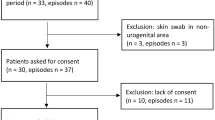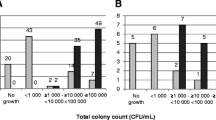Abstract
Recently, Aerococcus urinae, primarily recognized as a common pathogen in elderly women, has been reported to cause an extremely unpleasant odour of the urine in paediatric patients similar to trimethylaminuria (fish odour syndrome). Herein, we present a case of A. urinae urinary tract colonization in a 12-year-old otherwise healthy boy, who finally refused micturition outside from his home environment as a result of the unpleasant odour. Within the last year, three cases (including our own) of A. urinae colonization causing foul-smelling urine in healthy children have been published, suggesting that this condition might be as frequent as trimethylaminuria. In case of polymicrobial growth in a urine specimen, A. urinae as the leading pathogen will usually be missed by routine bacteriological investigation. Novel bacteriological techniques such as MALDI-TOF MS provide a rapid tool to recognize this pathogen in urine. Conclusion: As treatment of A. urinae infection is simple, we recommend that in healthy children with malodorous urine, this pathogen is excluded before the initiation of costly metabolic investigations.
Similar content being viewed by others
Abbreviations
- A. urinae :
-
Aerococcus urinae
- FMO3:
-
Flavine-containing monooxigenase-3
- MALDI-TOF MS:
-
Matrix-assisted laser desorption ionization time of flight mass spectrometry
- TMA:
-
Trimethylamine
References
Bos LD, Sterk PJ, Schultz MJ (2013) Volatile metabolites of pathogens: a systematic review. PLoS Pathog 9:e1003311
De Vries TW, Brandenburg AH (2012) Foul smelling urine in a 7-year-old boy caused by Aerococcus urinae. Pediatr Infect Dis J 31:1316–1317
Ferreira L, Sanchez-Juanes F, Gonzalez-Avila M, Cembrero-Fuciños D, Herrero-Hernãndez A, Gonzãlez-Buitrago JM, Muñoz-Belido JL (2010) Direct identification of urinary tract pathogens from urine samples by matrix-assisted laser desorption ionization-time of flight mass spectrometry. J Clin Microbiol 48:2110–2115
Gibb AP, Sivaraman B (2013) A second case of foul smelling urine in a boy caused by Aerococcus urinae. Pediatr Infect Dis J 32:1300–1301
Messenger J, Clark S, Massick S, Bechtel M (2013) A review of trimethylaminuria: (fish odor syndrome). J Clin Aesthet Dermatol 6:45–48
Mitchell SC, Smith RL (2001) Trimethylaminuria: the fish malodor syndrome. Drug Metab Dispos Biol Fate Chem 29:517–521
Murray TS, Muldrew KL, Finkelstein R, Hampton L, Edberg SC, Cappello M (2008) Acute pyelonephritis caused by Aerococcus urinae in a 12-year-old boy. Pediatr Infect Dis J 27:760–762
Rasmussen M (2013) Aerococci and aerococcal infections. J Infect 66:467–474
Sierra-Hoffman M, Watkins K, Jinadatha C, Fader R, Carpenter JL (2005) Clinical significance of Aerococcus urinae: a retrospective review. Diagn Microbiol Infect Dis 53:289–292
Subcommittee on Urinary Tract Infection SCOQI, Management, Roberts KB (2011) Urinary tract infection: clinical practice guideline for the diagnosis and management of the initial UTI in febrile infants and children 2 to 24 months. Pediatrics 128:595–610
Treacy E, Johnson D, Pitt JJ, Danks DM (1995) Trimethylaminuria, fish odour syndrome: a new method of detection and response to treatment with metronidazole. J Inherit Metab Dis 18:306–312
Acknowledgments
NR is supported by a career advancement grant of the University of Basel. The authors would like to thank Dr. Reno Frei for performing the MALDI-TOF MS in the microbiology laboratory at the Basel University Hospital and for helpful comments on the manuscript. They would also like to thank Dr. Martina Huemer, working as an external metabolic consultant at the University Children’s Hospitals of Zurich and Basel, for her support in initiating the metabolic urine analysis and for her helpful comments on the manuscript. Finally, the authors would like to thank Dr. Claus-Dieter Langhans for performing the GCMS analysis at the metabolic laboratory of the Heidelberg University Hospital and for his helpful comments on the manuscript.
Conflict of interest
The authors declare that there are no conflicts of interest.
Author information
Authors and Affiliations
Corresponding author
Additional information
Communicated by Beat Steinmann
Rights and permissions
About this article
Cite this article
Lenherr, N., Berndt, A., Ritz, N. et al. Aerococcus urinae: a possible reason for malodorous urine in otherwise healthy children. Eur J Pediatr 173, 1115–1117 (2014). https://doi.org/10.1007/s00431-014-2348-9
Received:
Revised:
Accepted:
Published:
Issue Date:
DOI: https://doi.org/10.1007/s00431-014-2348-9




